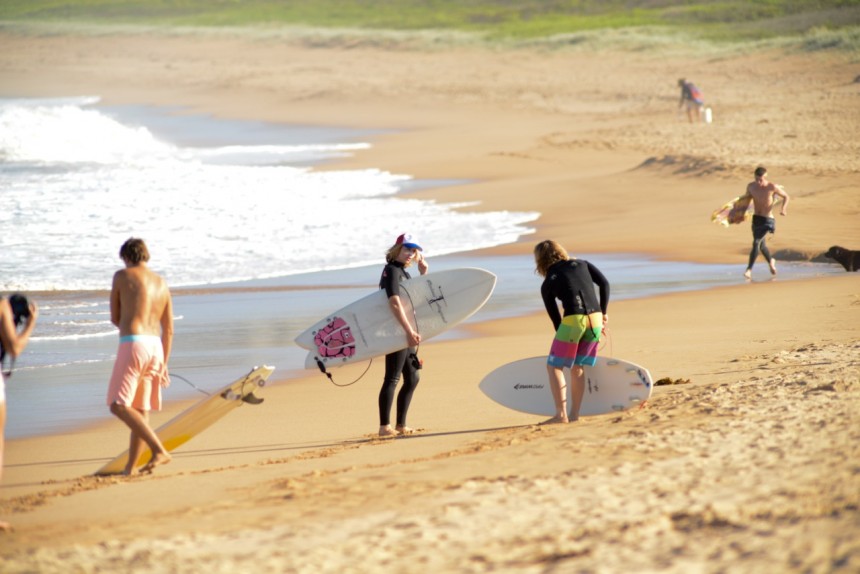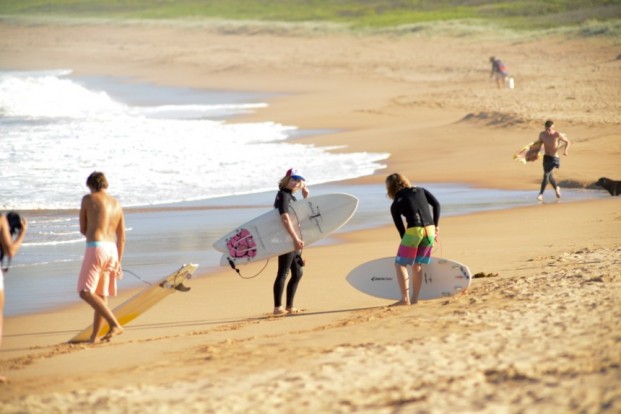So last Friday night I went and saw
Out in theLineup, which was showing as part of the
Byron Bay Film Festival.
Out in the Lineup is that film about gay and lesbian surfers that you have been hearing about for a while now, and which I have been really looking forward to seeing.
‘Out in the Lineup’ uncovers a culture that has strayed from its foundation of freedom of spirit, open-mindedness and connection to nature. David [Wakefield] and Thomas [Castets] learn about the dominance of male rituals in surf culture and the way this has marginalised minorities. They also hear about the pivotal role sponsors and media play in maintaining out-dated stereotypes. On ground level they hear stories of fear, isolation and self-doubt, but they are also inspired by tales of hope, self-empowerment and transformation.
Beyond simply exposing this taboo issue, this film seeks to affect change. It aims to confront the surf industry and the wider surfing community, creating awareness, provoking discussion and challenging stereotypes. Through this, ‘Out in the Lineup’, seeks to pave the way for a younger generation of surfers, creating a culture in which they can connect with each other and be themselves.
I have keenly followed the whole process of fundraising and promotion for this film, and have been particularly stoked with the way that sections of the surf media seemed to be getting behind it, and the issues that sit at its core. While surfing culture likes to portray itself as welcoming and accepting and a sport for everyone, in reality this often does not extend as far as we all like to think. Case in point is the hesitation so many gay and lesbian people feel in coming out to their surfing friends and community, and in being able to talk about what it’s like to be homosexual in a heterosexist culture.
This was certainly the experience of ex-state champion surfer, David Wakefield, the film’s protagonist. According to the film’s website, “David’s greatest fear was that he would be found out and rejected by his family, friends and the surfing community that had become his life.”
Sadly, David’s fears were not unfounded. Even today, many gay surfers are in a similar predicament. Some have witnessed ‘poofter bashing’ in the surfing community, some have been bullied in the line-up and others have been rejected by family and friends. In the most tragic cases, some have even taken their own lives as a result of non-acceptance. In professional surfing, several gay athletes have been told that their sexuality is incompatible with the expectations of their sponsors. As a result, many have lived in secrecy and some have walked away from competition.
Of course, homophobia is not just in media, or in industry, but extends to the everyday lineups around Australia and the world, where being gay is located as unacceptable in a range of ways. One strong of how this works is through the continuing use of words like ‘gay’, ‘fag’, ‘homo’, ‘poofter’, ‘leso’, to describe pulling back on a wave, saying something emotional, showing softness and care for your mates, or, in the case of women, being too strong. If being a homo is so insulting, why would anyone come out? By challenging straight ideas about what it’s like to be homosexual in the surf, the film illustrates how the ‘problem’ of homosexuality in surfing is cultural in a range of ways. That is, that being gay or lesbian or bisexual in surfing is not okay, and that surfers who aren’t straight face a raft of challenges and exclusions – implicit and explicit – that straight surfers don’t. Cori Schumacher has written a few pieces about why
Gay Surf Narratives Matter, over on her blog, and Clif Evers has written about homophobia in surfing culture in his essay,
Queer Waves. It’s worth checking out as they both go into
much more detail about it than I do in this review.
Out in the Lineup spoke with gay, lesbian and straight surfers from a range of national and ethnic backgrounds as well as from a range of age-brackets. For most of the people interviewed they explained how they thought that there weren’t really any gay people who surfed. For the surfers interviewed, this made them feel alone: for the straight surfers, it was something they didn’t have to think about. As Barton Lynch pointed out, you think there’s no homosexuality in surfing and then you find out your brother is gay and that it’s been there around you the whole time.
The film was thoughtful, well-paced, interesting, and featured surfing abilities ranging form world, national and state champions, to less spectacular, but still committed, recreational surfers. The whole film carries a spirit of openness, vulnerability, conversation, inclusivity and encouragement. This film goes further than the usual surf film by asking questions about the culture of surfing, questions about things that many of us take for granted everyday. It delves deep into the culture of surfing – into the culture that shapes and enables and enriches and limits the access that people have to that beautiful thing that we love to do. Pretending that surfing is only about catching waves ignores the complexity of the lineups and surfbreaks that we paddle out into everyday, and denies the ways that so many people are excluded from participating fully and without fear. It also denies the role that straight surfers play in shaping that exclusion, even if we don’t mean to.
And this is where the core of much of the issue is – that many straight people think there is no problem. That many straight people think that there is no homophobia, or that there are really no gay or lesbian people in the surf. But the film reveals that in fact, the gay and lesbian people around you often still feel too uncomfortable about surfing cultural attitudes and assumptions to come out. So despite straight people thinking there is a problem, many gay and lesbian people still hide that part of their identity.
Can you imagine feeling like this? I can’t. I haven’t had to. And that’s why this is a really important film. It’s important because it talks to people about what their experiences are like and shows that there are heaps of not-straight crew who surf. But it’s just as important in that it talks to the broader surfing community to explain the kinds of challenges that gay and lesbian surfers can face. Of course, this all brings many positive chances to explore new perspectives, new experiences, new relationships, new possibilities as well, and many of the surfers in the film highlight the joy that comes with discovering new things about yourself. Throughout and beyond the difficult periods, there are waves to be caught, art to be made, relationships to be begun and love to be made. But, with the joy, comes the negotiations of how our sexuality can shape the ways we are able to participate in surfing. And all of that is what this film explores.
Websites like gaysurfers.net and films like Out in the Lineup are really important in helping to give these experiences a voice in surfing. For gay and lesbian surfers, they highlight that there are other gay and lesbian surfers around, and for straight surfers, they provide a chance for us to listen, watch and learn, and to try to understand that there are a raft of things going on out in the lineup that we might not notice or understand. And this brings me to something about this film that made me really frustrated.
Usually when a surf film shows in Byron Bay, the local surfing community is out in force, supporting the film, the director, the surfers, and excited by the chance to socialise and watch some surfing on a big screen. But at this film showing, there was none of that crew. None. I knew a couple of people who were there, but the people who turn out in hordes for any film or art exhibition that engages with surfers’ connection to the ocean, to the past, to their cultural heritage, to risk-taking, to travel, to going to a Byron party and taking loads of drugs, none of that crew were there. And what the fuck is up with that? This film won the Best Surf Film award for the festival, but the local surf scene stayed away.
In their Q&A at the end of the film, Thomas Castets and Ian Thomson explained that they have had little success in getting the straight surfing community to attend showings of the film, which was a story totally in action at the Byron Bay showing as well. And look, maybe everyone is busy with the Quiky pro, or heading up to the Noosa Surf Festival and so are too distracted? I don’t know. But on the other hand, why not make time for it? And as for the visiting surfers, why did none of that crew come down for it? That’s what being part of a community is about – for surfers and for surf-film makers, of which there are plenty on the north coast. To be honest, it’s hard for me to write this because I don’t want to suggest that this community doesn’t care about homophobia and the challenges face by gay and lesbian surfers, because I’m quite sure that they do. But the absence of the people who usually attend surf film events in great numbers was really startling to me. Because the Byron surf community promotes itself as engaged with and accepting of diversity amongst surfers and surfing performances. But promoting ourselves as accepting of diversity is not enough – we need to live that acceptance and engagement across the board. Otherwise, it’s empty words.
And don’t for a minute think that I’m suggesting this is a Byron thing. Instead, I’m suggesting this is a surfing thing and that this showing is an illustration of the lack of engagement that the surfing community has shown with these issues.
As I left, I wondered – had I done enough to promote
Out in the Lineup myself? Had I talked about it enough, mentioned it enough? Could I have put it on Instagram? Would that have made a difference? But I really don’t know if it would have, and that’s the thing that is really bumming me out. So here is my final attempt at promoting this film and at encouraging surfers and surf film-makers to attend and to engage with the issues the film raises and to think about the experiences of some other surfers in the lineup – experiences which you might not have considered before. See
Out in theLineup, because it’s really interesting and well-made. See it because there is some really great surfing in it. See it because it might make you think about the ways that your own participation in the lineup has effects that you haven’t considered before – effects that you don’t even intend. See it because liking surfing and surf films is about more than pretty pictures and people, but is about the gritty, grimy, difficult stuff of everyday life and relationships, and, if you ask me, that is pretty fucking cool.
But most of all, see this film because it’s really, really good.



